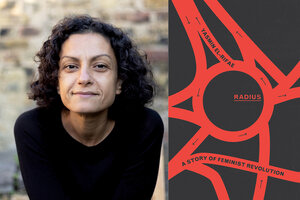Protecting female protesters during Egypt’s Arab Spring revolution
Activist Yasmin El-Rifae helped rescue women from sexual assault during Arab Spring protests in Egypt. She talks about her book “Radius,” which confronts the issue of women’s safety.

Yasmin El-Rifae is the author of "Radius: A Story of Feminist Revolution."
Hanan Abdalla/Verso Books
Egyptian journalist Yasmin El-Rifae is a founding member of Operation Anti-Sexual Harassment and Assault (known as Opantish), which sought to protect women from sexual violence during the Arab Spring revolution in Egypt in the early 2010s. In “Radius: A Story of Feminist Revolution,” Ms. Rifae shares moving – and often graphic but never gratuitous – stories about the group’s efforts to rescue female protesters caught in mobs of largely male demonstrators. Opantish sought not only to assist women who had been sexually assaulted but also to empower them to continue protesting safely. She spoke recently with the Monitor.
What does the title “Radius” refer to?
The title alludes to the very concrete physical action of these intervention teams that Opantish deployed, which would essentially cut a line through the mob to get to the woman at the center and then come back out that same way. It’s also on a metaphorical level referring to the need to break the ways that conversation around sexual violence often gets circled off or separated away from other kinds of political or social problems.
What did you see in Tahrir Square?
The revolution involved protests all around the country, but Tahrir was always the symbolic heart of it. At some point in late 2012, we started to see a pattern of mob sexual assaults that seemed to be targeting women protesters. So Opantish came together to intervene in these attacks and pull women out. … It involved both men and women on the ground, but the decision-making and the leadership was women-led.
The group was intensely active for about seven months, and in that time really learned how to do the work more efficiently and safely, because at first it was chaotic, and we didn’t really know what we were up against. Women in particular became targets of attacks themselves in the course of trying to help other women.
We would deploy these intervention teams that sometimes would be something [like] 10 and 20 people. And then we learned how to move that group in a formation through the crowd, to both intervene more effectively and try to keep people safe.
Iranian women protested for months. What did you think when you saw that?
It’s about the body, right? It’s about where women can be, and how they can dress, and how they can’t dress, how they can move, and how they can’t move. I see it as brave. The fact that it’s inspired such solidarity is really a testament to how viscerally women understand and share the fight. Women understand it on almost a cellular level.
What do people miss when they focus on sexual violence as a product of a specific culture or religion?
[Sexual violence] happens every day to people all around the world. It’s not very useful to use religious or cultural explanations for it. It’s both much bigger and more everyday than that.
You also run the risk of [the issue of] sexual violence, or women’s rights more broadly, becoming politically weaponized against a certain culture or religion, which is something that has happened a lot in the Middle East.
Is the answer to provide safe spaces for women protesters?
It’s important that [safe spaces] doesn’t get translated into separate spaces for women. ... I think that that ultimately harms the larger political project because it’s separating women at a moment when [the revolution is] ... supposed to be at [its] most bold and fearless and empowered.

